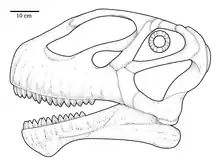Turiasauria
Turiasauria is an unranked clade of basal sauropod dinosaurs known from Middle Jurassic to Early Cretaceous deposits in Europe, North America, and Africa.
| Turiasaurs | |
|---|---|
.png.webp) | |
| Amanzia skeletal reconstruction, showing known material in blue | |
 | |
| Moabosaurus, with an incorrect Camarasaurus like head | |
| Scientific classification | |
| Kingdom: | Animalia |
| Phylum: | Chordata |
| Clade: | Dinosauria |
| Clade: | Saurischia |
| Suborder: | †Sauropodomorpha |
| Clade: | †Sauropoda |
| Clade: | †Eusauropoda |
| Clade: | †Turiasauria Royo-Torres et al., 2006 |
| Genera[1] | |
Description
Turiasauria was originally erected by Royo-Torres et al. (2006) to include Turiasaurus, Galveosaurus and Losillasaurus, all of which hail from the Villar del Arzobispo Formation (Tithonian-Berriasian) of Spain. Turiasuria was defined by the authors as "all Eusauropoda closer to Turiasaurus riodevensis than to Saltasaurus loricatus".[3] Cladistic analysis (Royo-Torres et al., 2006; 1927) of 309 characters and 33 taxa suggests that the turiasaurians lie outside the Neosauropoda and form a monophyletic group. The clade is diagnosed by the presence of vertical neural spines, posterior centroparapohyseal laminae on the dorsal vertebrae, the absence of pre- and postspinal laminae on the dorsal vertebrae, the absence of a scapular acromial crest, the presence of a prominent humeral deltopectoral crest, medial deflection of the proximal end of the humerus, and a distinct vertical ridge on the caudal side of the distal half of the ulna.

Paleobiogeography
Turiasaurs were initially considered confined to Europe, with Turiasaurus from Spain and Zby from Portugal,[4] and the tooth taxa Cardiodon, Neosodon, and Oplosaurus were referred to the clade, but additional members were found in North America and Africa.
Remains of a very large species of turiasaur, not yet formally identified, have recently been unearthed in Charente, West France.[5]
Indeterminate turiasaur material, consisting of a single vertebra, has been described from an unknown locality in the Early Cretaceous Wealden Group of England.[6]
Classification
Turiasaurus demonstrates that the evolution of enormous body size was not restricted to neosauropod clades such as the Diplodocidae and Titanosauria, but developed independently at least once in a lineage of more basal sauropods, the turiasaurians.
A 2009 thesis published by José Barco proposed that neither Galveosaurus nor Losillasaurus were turiasaurians.[7] Later, a master thesis by Francisco Gascó (2009) and Royo-Torres et al. (2009) reaffirmed the validity of Turiasauria.[8][9]
References
- Holtz, Thomas R. Jr. (2012) Dinosaurs: The Most Complete, Up-to-Date Encyclopedia for Dinosaur Lovers of All Ages, Winter 2011 Appendix.
- Mannion PD. 2019. A turiasaurian sauropod dinosaur from the Early Cretaceous Wealden Supergroup of the United Kingdom. PeerJ 7:e6348 https://doi.org/10.7717/peerj.6348
- Royo-Torres, R.; Cobos, A.; Alcalá, L. (2006). "A Giant European Dinosaur and a New Sauropod Clade". Science. 314 (5807): 1925–1927. Bibcode:2006Sci...314.1925R. doi:10.1126/science.1132885. PMID 17185599.
- Mateus, Octávio; Mannion, Philip D.; Upchurch, Paul (16 April 2014). "Zby atlanticus, a new turiasaurian sauropod (Dinosauria, Eusauropoda) from the Late Jurassic of Portugal". Journal of Vertebrate Paleontology. 34 (3): 618–634. doi:10.1080/02724634.2013.822875.
- Allain, Ronan, editor (2017): Dinosaures. Les géants du vignoble. Angoulême: Eidola éditions, 248 p.
- Mannion, Philip D. (2019-01-24). "A turiasaurian sauropod dinosaur from the Early Cretaceous Wealden Supergroup of the United Kingdom". PeerJ. 7: e6348. doi:10.7717/peerj.6348. ISSN 2167-8359. PMC 6348093. PMID 30697494.
- José Luis Barco Rodríguez, Sistemática e implicaciones filogenéticas y paleobiogeográficas del saurópodo Galvesaurus herreroi (Formación Villar del Arzobispo, Galve, España), 2009, Universidad de Zaragoza.
- Gascó, F (2009): Sistemática y anatomía funcional de Losillasaurus giganteus Casanovas, Santafé & Sanz, 2001 (Turiasauria, Sauropoda). Universidad Autónoma de Madrid.
- Royo-Torres, R.; Cobos, A.; Aberasturi, A.; Espilez, E.; Fierro, I.; González, A.; Luque, L.; Mampel; Alcalá, L. (2009). "High European sauropod dinosaur diversity during Jurassic-Cretaceous transition in Riodeva (Teruel, Spain)". Palaeontology. 52 (5): 1009–1027. doi:10.1111/j.1475-4983.2009.00898.x.
Sources
- Barco, J. L., Canudo, J. L., Cuenca-Bescós, G. & Ruíz-Omeñaca, J. I., (2005): Un nuevo dinosaurio saurópodo, Galvesaurus herreroi gen. nov., sp. nov., del tránsito Jurásico-Cretácico en Galve (Teruel, NE de España). Naturaleza Aragonesa: Vol. 15, pp 4–17
- Casanovas, M. L.; Santafe, J. V.; Sanz, J. L. (2001). "Losillasaurus giganteus, un nuevo saurópodo del tránsito Jurásico-Cretácico de la Cuenca de "Los Serranos" (Valencia, España)". Paleontologia I Evolució (32–33): 99–122.












